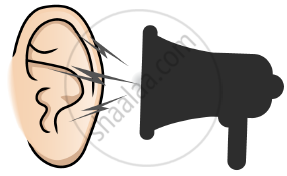Advertisements
Advertisements
Question
With reference to the human ear, answer the question that follow:
Name the part of the ear associated with
(1) static balance
(2) hearing
(3) dynamic balance.
Solution
(1) Static balance - Utriculus and sacculus (inner ear)
(2) Hearing - Internal ear
(3) Dynamic balance - Semi-circular canals (inner ear)
RELATED QUESTIONS
Explain how the human ear works.
Write short notes on the following: Cochlea
Given below is a representation of a kind of pollution. Study the same and answer the questions that follow

(i) Name the kind of pollution.
(ii) List any three common sources of this pollution.
(iii) Mention three harmful effects of this pollution on human health.
(iv) Explain the term ‘Pollutant’.
(v) Name two soil pollutants
Name the following:
The part which equalises the air pressure in the middle and external ear.
Name the following:
The nerves which transmit impulse from ear to the brain.
Name that part of ear which vibrates when outside sound falls on it.
Name the three tiny bones present in the middle part of ear.
Name the following:
Part of internal ear related to balance.
The following diagram refers to the ear of a mammal.

(i) Label the parts 1 to 10 to which the guidelines point.
(ii) Which structure:
(a) converts sound waves into mechanical vibrations?
(b) Converts vibrations into nerve impulses?
(c) Responds to change in position?
(d) Transmits impulses to the brain?
(e) Equalizes atmospheric pressure and pressure in the ear.
Mention, if the following statement is True or False
The part of ear associated with balance is the cochlea.
State the functions of the following:
Semi-circular canals
Describe the structure and function of the human ear?
Select the CORRECT match of part of the human ear and its function.
The part of the ear that turns pressure variations into electrical signals is ______.
In the inner ear, the pressure variations are turned into electrical signals by the ______.
The median canal of cochlea is filled with ______.
The part of the inner ear which is responsible for hearing is ______.
- Draw a neat and well labelled diagram of the membranous labyrinth found in the inner ear.
- Based on the diagram drawn above in (i), give a suitable term for each of the following descriptions:
- The structure responsible for hearing.
- The sensory cells that help in hearing.
- The membrane-covered opening that connects the middle ear to inner ear.
- The nerves that carry impulses from the ear to the brain.
- The tube which equalises the air pressure on either side of the ear drum.
